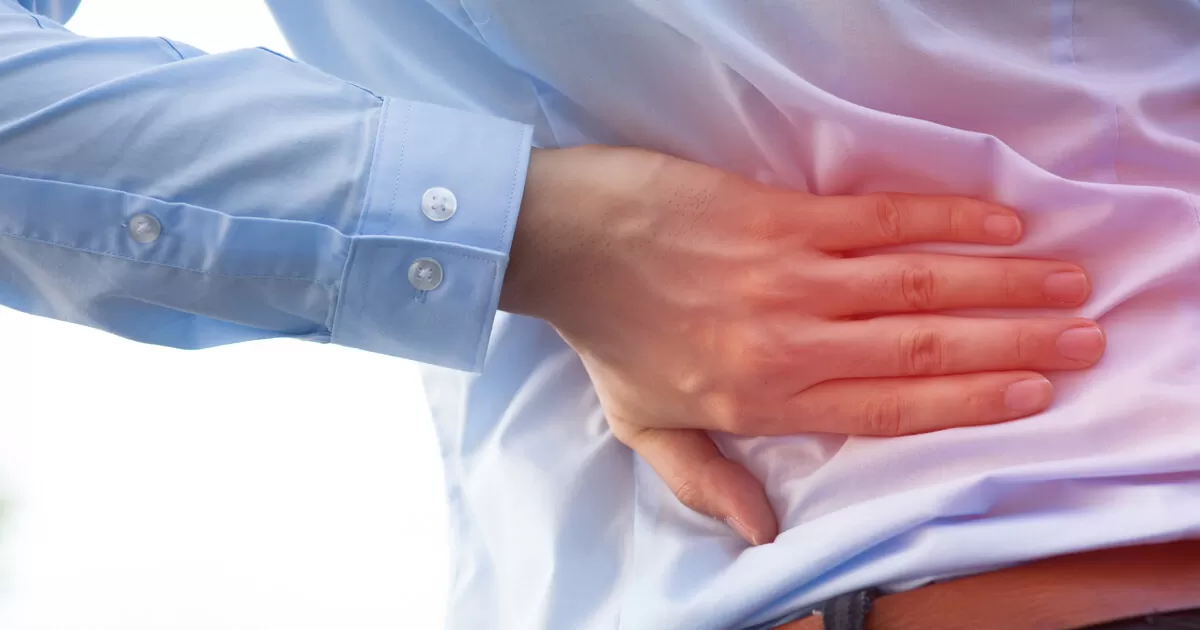Low Back Pain and What You Can Do About It

If there’s one medical condition that many of us might have in common, it’s low back pain. Here are some facts that highlight just how widespread low back pain is:
- It affects 8 out of every 10 adults at some point in their life.
- It affects men and women equally.
- In 2010, it caused more disability globally than any other medical condition.
- It is the most common cause of job-related disability and one of the main reasons why people miss days of work.
- In 2013, nearly 3 out of every 10 adults report having had low back pain in the past 3-month period.
Are there different types of low back pain?
There are two types of low back pain: acute and chronic.
Acute low back pain lasts a few days to a few weeks. It usually goes away with self-care and does not cause any long-term issues. Acute low back pain is usually caused by sudden injury to muscles or ligaments that support the back (think falls or heavy lifting).
Chronic low back pain lasts 12 weeks or longer—even after the cause of the acute low back pain has been treated. About 2 out of every 10 people who have acute low back pain develop chronic low back pain.
What causes low back pain?
There are many causes of low back pain, as well as factors that can lead to it. These include:
- Strains/sprains. A strain is a stretched or torn muscle or tendon (tissues that connect muscle to bone). A sprain is a stretched or torn ligament (tissues that connect bones at a joint).
- Disc degeneration. Happens when the rubbery discs in the spine lose their cushioning ability.
- Herniated/ruptured discs. Occurs when discs become compressed and bulge outward (herniation) or rupture.
- Sciatica. Refers to pain caused by compression of the sciatic nerve, a large nerve that runs from buttocks and down the back of the leg.
- Spinal stenosis. A narrowing of the spinal column that can lead to pain and numbness when walking and eventually to a loss of feeling.
- Trauma/injury. Playing sports, falling, or being in a car accident can injure the muscles, tendons, or ligaments in the lower back. Trauma/injury can also lead to herniated or ruptured discs.
- Skeletal irregularities. Includes curvature of the spine (called scoliosis) or severe arch in the lower back (called lordosis).
- Underlying medical conditions. Includes osteoporosis (loss of bone density and strength), endometriosis (a buildup of uterine tissue outside the uterus), and fibromyalgia (chronic muscle pain and fatigue).
What are the risk factors for low back pain?
- Aging. As people get older, they lose bone strength and muscle tone and elasticity. In addition, the discs in the spine are less able to cushion their vertebrae (bones in the spine that protect the spinal cord and nerves and that support the body).
- Poor physical fitness. Back pain is more common in people who are not physically fit. This happens because weaker back and stomach muscles may not support the spine properly.
- Being overweight. People who are overweight or who gain a lot of weight quickly put extra stress on the back.
- Doing physically demanding work. People whose jobs require heavy pushing, pulling, or lifting are at risk for back injury and pain.
- Having a desk job. Sitting at a desk all day can lead to back pain, especially in people who have poor posture or whose chair does not provide enough support.
- Pregnancy. Many pregnant women have acute low back pain. This happens because of changes in the pelvis and weight distribution of the body. This type of low back pain usually goes away after child birth.
What are the treatment options for low back pain?
Acute low back pain usually gets better with an over-the-counter pain reliever to ease the pain. A healthcare provider can recommend over-the-counter medicines as well as a course of action. They can also explain the possible benefits of treatments such as heat or cold therapy and massage therapy.
It is usually recommended that people with acute low back pain stop their normal physical activity for the first few days, but always talk with your healthcare provider about the specific care plan you should follow. When resuming your normal activities, slowly ease into them. For example, begin with activities like walking, riding a stationary bike, and swimming. Also talk with your healthcare provider about the types of stretching and strengthening exercises that you can do for your back.
Treatment options for chronic low back pain include:
- Physical therapy and exercise. A physical therapy program can include exercises and techniques to strengthen muscles that support the lower back. Exercise can help ease the pain and may reduce the risk of the pain coming back. It’s important to talk with a healthcare provider before continuing or starting an exercise program.
- Medicines. These include over-the-counter or prescription pain medicines. You and your healthcare provider can discuss the best option for your low back pain.
- Complementary and alternative treatments. These treatments include spinal manipulation, acupuncture, massage, and yoga.
- Surgery. This is usually reserved for people who do not get adequate relief from nonsurgical treatments and those who may have structural changes such as herniated discs or spinal stenosis.
It’s important for some people who suffer from chronic low back pain to have a realistic expectation of the level of pain relief and activity they will get from pain management. If you have chronic low back pain, it may be helpful for you and your healthcare provider to talk about treatment goals. Be sure to review your goals periodically.
When should someone with low back pain see a doctor?
It may not be necessary for you to see a doctor for a minor backache right away, but you should call your doctor if:
- The pain doesn’t start to go away after 72 hours of self-care.
- The pain gets worse.
- You have any numbness, tingling, or difficulty moving.
However, see your healthcare provider as soon as possible if your back pain is from a severe fall or injury; or if you have back pain together with trouble urinating; weakness, pain, or numbness in the legs; fever; or sudden weight loss.
Alexander Schepart, PharmD, MBA, is a pharmacist and Senior Medical Manager in Pfizer Consumer Healthcare.
Vineeth Nair, PharmD, is a pharmacist and Post-Doctoral Fellow working in Pfizer Consumer Healthcare.
[1][2][3][4][5][6][7][8][9][10][11]
References
- 1. National Institutes of Health, National Institute of Neurological Disorders and Stroke. Low Back Pain Fact Sheet. Accessed June 22, 2017.
- 2. Hoy D, March L, Brooks P, et al. The global burden of low back pain: estimates from the Global Burden of Disease 2010 study. Ann Rheum Dis. 2014;73:968-974.
- 3. Centers for Disease Control: Severe headache or migraine, low back pain, and neck pain among adults aged 18 and over, by selected characteristics: United States, selected years 1997–2013. Accessed May 15, 2017.
- 4. Terrie YC. A Pharmacist’s Guide to OTC Therapy: Acute Lower Back Pain. Pharmacytimes.com. September 2008;1-3. Accessed April 6, 2017.
- 5. Cedars-Sinai®. Vertebrae of the Spine. Accessed May 15, 2015.
- 6. National Institutes of Health, National Institute of Arthritis and Musculoskeletal and Skin Diseases. Handout on Health: Back Pain. Accessed April 6, 2017.
- 7. National Institutes of Health, National Center for Complementary and Integrative Health. Chronic Low-Back Pain and Complementary Health Approaches. Accessed May 15, 2017.
- 8. Last AR, Hulbert K. Chronic low back pain: evaluation and management. Am Fam Physician. 2009;79(12):1067-1074.
- 9. U.S. National Library of Medicine. Musculoskeletal System. Accessed May 17, 2017.
- 10. National Institutes of Health/U.S. National Library of Medicine. MedlinePlus. Low Back Pain–Acute. Accessed June 22, 2017.
- 11. National Institutes of Health/U.S. National Library of Medicine. MedlinePlus. Sprains and Strains. Accessed June 22, 2017.





